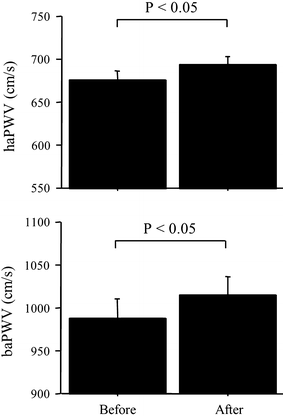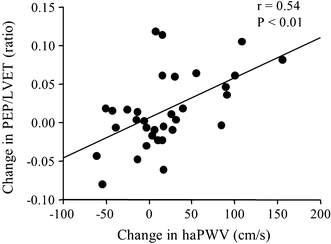Impact of short-term training camp on arterial stiffness in endurance runners
- PMID: 26037815
- PMCID: PMC10717420
- DOI: 10.1007/s12576-015-0383-6
Impact of short-term training camp on arterial stiffness in endurance runners
Abstract
Lack of elasticity in the central artery causes an increase in left ventricular (LV) afterload. Although regular moderate-intensity endurance exercise improves cardiovascular function, including arterial destiffening, little is known about the effect of short-term vigorous exercise on cardiovascular function (i.e., the interaction between cardiac and arterial functions). We measured arterial stiffness [via pulse wave velocity from the heart to ankle (haPWV)] and LV contractility (via systolic interval time) before and after a 1-week training camp in a total of 33 regularly highly-trained collegiate endurance runners. They participated in three training sessions per day which mainly consisted of long-distance running and sprint training. The averaged running distance was ≈ 44% longer during the camp than the regular training program. After the camp, heart rate at rest and haPWV were significantly increased, whereas blood pressure remained unchanged. Although a ratio of pre-ejection period and LV ejection time (PEP/LVET, an index of blunted LV contractility) was unaltered, presumably due to the large variability of individual response, there was a significant correlation between changes in haPWV and PEP/LVET (r = 0.54, P < 0.01). These results suggest that, in regularly highly-trained endurance athletes, arterial stiffness increases after a training camp characterized by greater training volume (vs. regular training), and that the individual response in arterial stiffness correlates with the corresponding changes in myocardial contractility.
Conflict of interest statement
None.
Figures


References
-
- Nichols WW, McDonald DA. McDonald’s blood flow in arteries : theoretic, experimental, and clinical principles. 6. London: Hodder Arnold; 2011.
-
- Safar ME, London GM. Therapeutic studies and arterial stiffness in hypertension: recommendations of the European Society of Hypertension. The Clinical Committee of Arterial Structure and Function. Working Group on Vascular Structure and Function of the European Society of Hypertension. J Hypertens. 2000;18:1527–1535. doi: 10.1097/00004872-200018110-00001. - DOI - PubMed
MeSH terms
LinkOut - more resources
Full Text Sources
Miscellaneous

